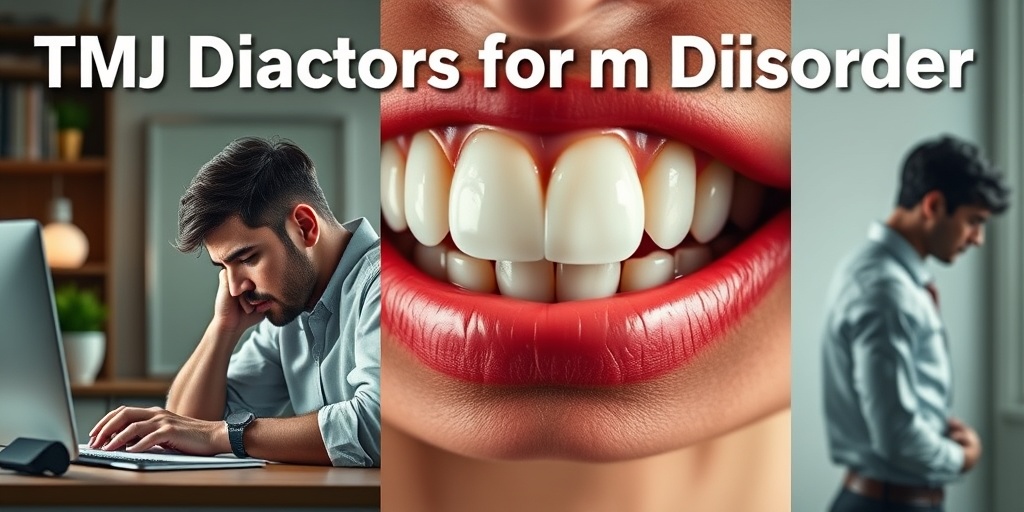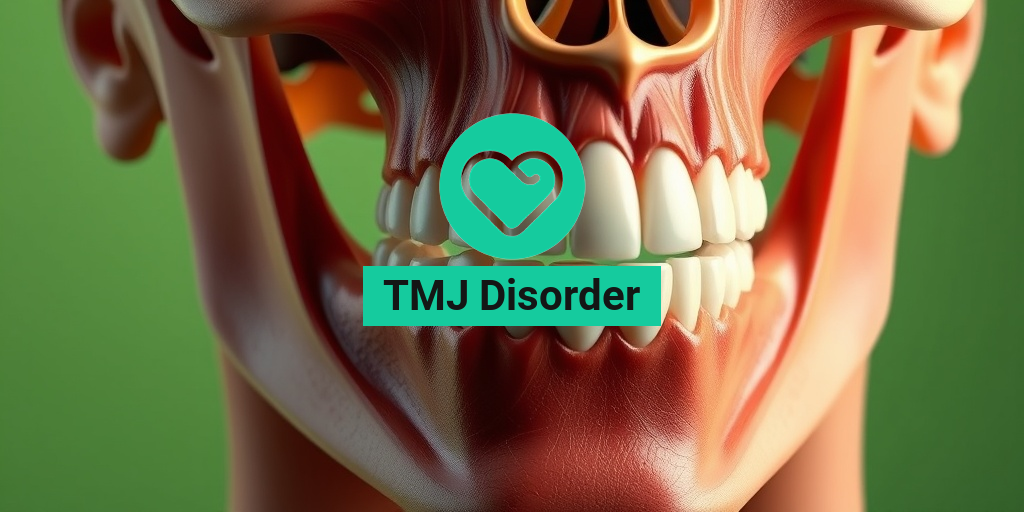What Is TMJ Disorder?
TMJ Disorder, or Temporomandibular Joint Disorder, refers to a group of conditions affecting the jaw joint and the surrounding muscles. The temporomandibular joint (TMJ) connects your jawbone to your skull, allowing you to perform essential functions like chewing, speaking, and yawning. When this joint becomes dysfunctional, it can lead to a variety of uncomfortable symptoms and complications.
TMJ Disorder can arise from several factors, including:
- Jaw injuries: Trauma to the jaw can disrupt the normal functioning of the TMJ.
- Teeth grinding (bruxism): This common habit can put excessive pressure on the jaw joint.
- Arthritis: Conditions like osteoarthritis or rheumatoid arthritis can affect the TMJ.
- Misalignment: An improper bite or jaw alignment can lead to strain on the joint.
Understanding TMJ Disorder is crucial for effective management and treatment. If you’re experiencing discomfort in your jaw or face, it may be time to consult a healthcare professional for a proper diagnosis and treatment plan. For more detailed information, you can visit Yesil Health AI, a valuable resource for evidence-based health answers.
TMJ Disorder Symptoms
Recognizing the symptoms of TMJ Disorder is essential for early intervention and treatment. Symptoms can vary widely among individuals, but some of the most common signs include:
- Jaw pain: This is often the most noticeable symptom, which can range from mild discomfort to severe pain.
- Facial pain: Pain may extend to the face, neck, and shoulders, making it difficult to pinpoint the source.
- Clicking or popping sounds: You may hear or feel a clicking or popping noise when opening or closing your mouth.
- Limited jaw movement: Some individuals may find it challenging to open their mouths fully or may experience a locked jaw.
- Headaches: Frequent headaches, particularly tension headaches, can be associated with TMJ Disorder.
- Ear pain or ringing: Some people report earaches or a sensation of fullness in the ears, even without an ear infection.
If you notice any of these symptoms, it’s important to seek medical advice. Early diagnosis and treatment can help alleviate discomfort and prevent further complications. Remember, TMJ Disorder is manageable, and various treatment options are available, ranging from lifestyle changes to medical interventions.
In conclusion, understanding TMJ Disorder and its symptoms is the first step toward effective management. If you’re experiencing any of these symptoms, consider reaching out to a healthcare professional for guidance. For more information and resources, visit Yesil Health AI to explore evidence-based health answers tailored to your needs. 😊

Causes of TMJ Disorder
TMJ Disorder, or temporomandibular joint disorder, affects millions of people worldwide. Understanding the causes of TMJ Disorder is crucial for effective management and treatment. This condition can arise from various factors, often interlinked, leading to discomfort and pain in the jaw area.
1. Jaw Injury
One of the most common causes of TMJ Disorder is a jaw injury. Trauma to the jaw, whether from an accident, sports injury, or even dental procedures, can disrupt the normal functioning of the temporomandibular joint. This disruption can lead to inflammation and pain.
2. Teeth Grinding and Jaw Clenching
Bruxism, or teeth grinding, is another significant contributor to TMJ Disorder. Many people grind their teeth unconsciously, especially during sleep or times of stress. This constant pressure can wear down the teeth and strain the jaw muscles, leading to discomfort and dysfunction.
3. Arthritis
Arthritis, particularly osteoarthritis and rheumatoid arthritis, can affect the TMJ. Inflammation from arthritis can lead to pain and stiffness in the joint, making it difficult to open and close the mouth comfortably.
4. Misalignment of the Jaw or Teeth
Another cause of TMJ Disorder is the misalignment of the jaw or teeth, known as malocclusion. When the upper and lower teeth do not fit together properly, it can place undue stress on the TMJ, leading to pain and dysfunction.
5. Stress and Anxiety
Emotional stress and anxiety can manifest physically, often resulting in muscle tension in the jaw. This tension can lead to jaw clenching and teeth grinding, exacerbating TMJ symptoms. Managing stress through relaxation techniques can be beneficial in alleviating these symptoms.
6. Other Medical Conditions
Several other medical conditions can contribute to TMJ Disorder, including:
- Fibromyalgia: This chronic pain condition can lead to widespread discomfort, including in the jaw.
- Chronic Fatigue Syndrome: Fatigue and muscle pain can also affect the jaw muscles.
- Sleep Disorders: Conditions like sleep apnea can lead to jaw clenching during sleep.
Risk Factors for TMJ Disorder
While anyone can develop TMJ Disorder, certain risk factors can increase the likelihood of experiencing this condition. Understanding these factors can help in prevention and early intervention.
1. Age and Gender
TMJ Disorder is more prevalent in individuals aged 20 to 40, and women are more likely to be affected than men. Hormonal differences may play a role in this disparity, as women often experience fluctuations in hormones that can influence pain perception.
2. Previous Jaw Issues
If you have a history of jaw problems, such as dislocations or previous TMJ issues, you may be at a higher risk for developing TMJ Disorder. Previous injuries can lead to long-term complications that affect the joint’s function.
3. Lifestyle Factors
Certain lifestyle choices can contribute to the development of TMJ Disorder. These include:
- High-stress levels: Chronic stress can lead to muscle tension and jaw clenching.
- Poor posture: Slouching or poor alignment can strain the jaw and neck muscles.
- Excessive caffeine or alcohol consumption: These substances can increase muscle tension and exacerbate symptoms.
4. Genetic Predisposition
Genetics can also play a role in the development of TMJ Disorder. If you have family members with jaw issues or arthritis, you may be more susceptible to similar conditions.
5. Dental Issues
Dental problems, such as missing teeth or poorly fitting dentures, can lead to misalignment of the jaw, increasing the risk of TMJ Disorder. Regular dental check-ups can help identify and address these issues early.
In conclusion, understanding the causes and risk factors of TMJ Disorder is essential for effective management. By recognizing these elements, individuals can take proactive steps to mitigate their risk and seek appropriate treatment when necessary. 🌟

Diagnosing TMJ Disorder
Diagnosing TMJ Disorder can be a complex process, as the symptoms often overlap with other conditions. The temporomandibular joint (TMJ) connects your jawbone to your skull, and when it becomes dysfunctional, it can lead to a variety of issues. Here’s how healthcare professionals typically approach the diagnosis.
Understanding the Symptoms
Before a diagnosis can be made, it’s essential to recognize the common symptoms associated with TMJ Disorder. These may include:
- Jaw Pain: Discomfort or pain in the jaw joint or surrounding muscles.
- Clicking or Popping Sounds: Noises when opening or closing the mouth.
- Limited Jaw Movement: Difficulty in fully opening or closing the mouth.
- Headaches: Frequent headaches or migraines that may be linked to jaw tension.
- Facial Pain: Pain that radiates to the face, neck, or shoulders.
Consultation and Medical History
The first step in diagnosing TMJ Disorder is a thorough consultation with a healthcare provider. During this visit, the doctor will:
- Review your medical history, including any previous jaw injuries or dental issues.
- Ask about your symptoms, their duration, and any factors that may exacerbate them.
- Inquire about your lifestyle, including stress levels and habits like teeth grinding or jaw clenching.
Physical Examination
After the consultation, a physical examination will typically follow. The healthcare provider will:
- Palpate the jaw muscles and joints to identify areas of tenderness.
- Assess jaw movement and listen for any clicking or popping sounds.
- Check for signs of teeth grinding or clenching.
Imaging Tests
In some cases, imaging tests may be necessary to confirm a diagnosis. These can include:
- X-rays: To view the structure of the jaw and identify any abnormalities.
- CT Scans: To provide detailed images of the TMJ and surrounding tissues.
- MRIs: To assess the soft tissues and cartilage of the joint.
Once all the information is gathered, your healthcare provider will be able to determine if you have TMJ Disorder and discuss potential treatment options tailored to your specific needs.
TMJ Disorder Treatment Options
Treating TMJ Disorder often requires a multifaceted approach, as the condition can vary significantly from person to person. Here are some common treatment options that healthcare providers may recommend:
Conservative Treatments
Many cases of TMJ Disorder can be managed with conservative treatments, which may include:
- Physical Therapy: Exercises designed to strengthen jaw muscles and improve flexibility.
- Heat and Cold Therapy: Applying heat or ice packs to reduce inflammation and relieve pain.
- Medications: Over-the-counter pain relievers or anti-inflammatory medications to manage discomfort.
Dental Interventions
If conservative treatments are ineffective, dental interventions may be necessary. These can include:
- Occlusal Splints: Custom-made mouthguards that help align the jaw and reduce teeth grinding.
- Dental Adjustments: Modifying the bite to alleviate pressure on the TMJ.
Alternative Therapies
Some individuals find relief through alternative therapies, which may include:
- Acupuncture: A technique that may help relieve pain and tension in the jaw.
- Massage Therapy: Targeted massage can help relax tight muscles around the jaw.
Surgical Options
In severe cases where other treatments have failed, surgical options may be considered. These can include:
- Arthroscopy: A minimally invasive procedure to diagnose and treat TMJ issues.
- Open Joint Surgery: A more invasive option for severe structural problems.
It’s essential to consult with a healthcare provider to determine the most appropriate treatment plan for your specific situation. With the right approach, many individuals can find relief from the symptoms of TMJ Disorder and improve their quality of life. 😊

Home Remedies for TMJ Disorder
Living with TMJ Disorder can be challenging, but there are several home remedies that may help alleviate symptoms and improve your quality of life. These remedies focus on reducing pain, improving jaw function, and promoting relaxation. Here are some effective strategies you can try:
1. Warm and Cold Compresses
Applying heat or cold to the jaw can significantly reduce pain and inflammation. Here’s how to use them:
- Warm Compress: Use a warm towel or heating pad on the affected area for 15-20 minutes. This can help relax the muscles and improve blood circulation.
- Cold Compress: Apply an ice pack wrapped in a cloth for 10-15 minutes to reduce swelling and numb the pain.
2. Gentle Jaw Exercises
Incorporating TMJ disorder exercises into your routine can help strengthen the jaw muscles and improve mobility. Here are a few simple exercises:
- Jaw Relaxation: Place your tongue on the roof of your mouth and gently open and close your jaw.
- Side-to-Side Movement: Move your jaw from side to side slowly, ensuring you don’t experience pain.
- Forward and Backward Movement: Push your jaw forward and then pull it back, repeating this motion gently.
3. Stress Management Techniques
Stress can exacerbate TMJ disorder symptoms. Incorporating relaxation techniques into your daily routine can be beneficial:
- Meditation: Spend a few minutes each day practicing mindfulness or meditation to reduce stress levels.
- Deep Breathing: Engage in deep breathing exercises to promote relaxation and decrease muscle tension.
- Yoga: Consider practicing yoga to improve flexibility and reduce stress.
4. Dietary Adjustments
What you eat can also impact your TMJ symptoms. Here are some dietary tips:
- Avoid Hard Foods: Steer clear of hard, chewy foods that can strain your jaw.
- Soft Foods: Opt for softer foods like yogurt, mashed potatoes, and smoothies to minimize jaw movement.
- Stay Hydrated: Drink plenty of water to keep your body hydrated and support overall health.
5. Herbal Remedies
Some people find relief from TMJ symptoms through herbal remedies. Consider trying:
- Ginger Tea: Known for its anti-inflammatory properties, ginger tea can help reduce pain.
- Chamomile: This calming herb can help relax your muscles and promote better sleep.
Living with TMJ Disorder
Living with TMJ disorder can be a daily challenge, but understanding the condition and implementing effective management strategies can make a significant difference. Here are some insights into navigating life with TMJ disorder:
Understanding Your Condition
TMJ disorder affects the temporomandibular joint, which connects your jaw to your skull. Symptoms can vary widely, but common issues include:
- Pain: Discomfort in the jaw, neck, or shoulders.
- Clicking or Popping Sounds: Noises when opening or closing the mouth.
- Limited Jaw Movement: Difficulty in fully opening or closing the mouth.
Seeking Professional Help
While home remedies can be effective, it’s essential to consult with a healthcare professional if symptoms persist. A dentist or a specialist in TMJ disorders can provide:
- Diagnosis: A thorough examination to determine the underlying cause of your symptoms.
- Treatment Options: Recommendations for treatments such as physical therapy, dental splints, or medications.
Adapting Your Lifestyle
Making lifestyle adjustments can also help manage TMJ disorder:
- Posture Awareness: Maintain good posture to reduce strain on your jaw and neck.
- Limit Jaw Movement: Avoid excessive yawning, chewing gum, or clenching your teeth.
- Regular Check-ups: Schedule regular dental visits to monitor your TMJ health.
By understanding your condition and implementing these strategies, you can lead a more comfortable life while managing TMJ disorder. Remember, you’re not alone in this journey, and support is available! 🌟

Frequently Asked Questions about TMJ Disorder
What is TMJ Disorder?
TMJ Disorder refers to a group of conditions affecting the temporomandibular joint (TMJ), which connects the jawbone to the skull. This disorder can lead to pain, discomfort, and difficulty in jaw movement.
What are the common symptoms of TMJ Disorder?
- Jaw pain or tenderness
- Clicking or popping sounds when moving the jaw
- Difficulty chewing or biting
- Facial pain
- Headaches or migraines
- Earaches or ringing in the ears
What causes TMJ Disorder?
Several factors can contribute to TMJ Disorder, including:
- Jaw injuries or trauma
- Teeth grinding or jaw clenching (bruxism)
- Arthritis in the jaw joint
- Stress, leading to muscle tension
- Misalignment of the teeth or jaw
How is TMJ Disorder diagnosed?
A healthcare professional typically diagnoses TMJ Disorder through a physical examination, patient history, and sometimes imaging tests like X-rays or MRIs to assess the joint’s condition.
What are the treatment options for TMJ Disorder?
Treatment for TMJ Disorder may include:
- Over-the-counter pain relievers
- Physical therapy and exercises
- Stress management techniques
- Dental splints or mouthguards
- In severe cases, surgical options may be considered
Are there exercises for TMJ Disorder?
Yes! Specific exercises can help alleviate symptoms of TMJ Disorder. These may include:
- Gentle jaw stretching
- Relaxation techniques for jaw muscles
- Range-of-motion exercises
Is TMJ Disorder common?
Yes, TMJ Disorder is relatively common, affecting millions of people worldwide. It can occur at any age but is most frequently seen in adults.
Can TMJ Disorder lead to other health issues?
If left untreated, TMJ Disorder can lead to chronic pain, headaches, and even affect overall quality of life. It’s essential to seek treatment if you experience persistent symptoms.
Where can I find more information about TMJ Disorder?
For more detailed information, consider consulting a healthcare professional or visiting reputable health websites that specialize in dental and jaw disorders.




